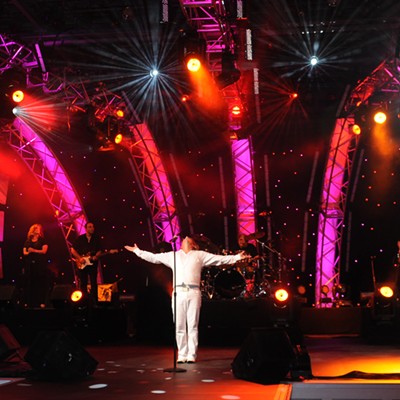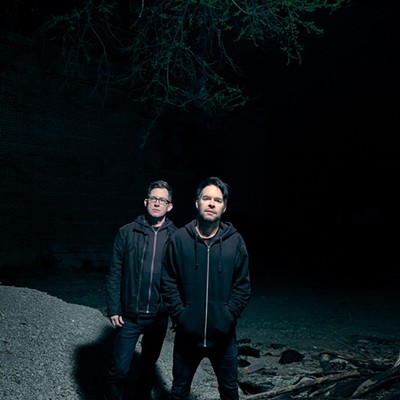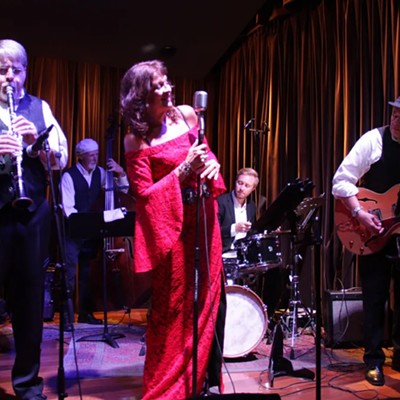Cave is a rarity in the music world. They set limitations for themselves that are ambiguous enough to incorporate whatever stylistic excursions they see fit. They have a single-minded creative goal that expands with each album they record and each show they play. They do what they want, and what they want seems to be to distance themselves as much as possible from controlling their own music. Cave initiates a composition, and then lets it finish itself.
If this doesn't sound like typical rock 'n' roll, well, that's because it isn't. Cave's output owes very little to any rock tradition, often resembling the early '70s work of avant-garde Germans Can or the same era of Miles Davis. Formed in Chicago in 2005, Cave has now solidified into the quartet of Cooper Crain (guitar, keyboards), Dan Browning (bass), Jeremy Freeze (guitar) and Rex McMurry (drums). On their third full-length album Threace, their mission of maximizing the texture of minimalist grooves and motifs has reached a stunning pinnacle—the record is all tense beauty born out of focused exploration.
Asked whether he considers Threace to be a departure or continuation of the band's prior releases, Crain explains, "It's both. It's a continuation of where we're heading. (The previous album and this one) are both groove-oriented. We've gotten better at playing over the years, within the group and listening to each other. It's an expansion, but there's also new territories that we're going into—we've already dabbled in weird time signatures and trying to make a groove. (We come from a) minimalist standpoint, trying to make grooves work in various ways and build tension, and be really repetitive, but interesting and vary things. That's the idea and the map behind everything, and the parts, sounds and instruments will vary, but that's the main idea we've had the whole time."
As with other Cave albums, 2009's Psychic Psummer and 2011's Neverendless, the band's collective songwriting approach remains rooted in spontaneous ensemble playing and chance, with recordings being edited using studio techniques after the fact. But on Threace, the band took that concept to new extremes, showing up at the studio with almost no material prepared, and using one (!) microphone to capture the entire band's performances. In other words, the listener is experiencing the group writing the song as it occurs. Cave recorded three of Threace's five songs—"Silver Headband," "Arrow's Myth," and "Slow Bern"—in this manner.
"It all comes from an improvisational point," Crain says. "It's been a long time since anyone (said), 'Hey, I have this riff,' that's totally all written and everything. It's been years since that's happened. On this record it was done a little differently. We've jammed in the studio before and then edited stuff afterwards, and that's not a new thing on our albums. But I guess what makes this different (from) a more fresh, first-take improvisational standpoint is that we didn't just throw up mics and just play. We threw up one mic, heard what that sounded like, adjusted our volumes and how we were playing to that. We kind of made songs based on the sound of the room and the microphone placement."
The band would further experiment with different instrumentation, including horns and flutes—whatever they had to do to perfect an environment where the songs would become separate entities, guiding themselves. Crain says, "(For example), this sounds cool—'I'm gonna play the Wurlitzer (a vintage electric keyboard used throughout experimental jazz and rock) because the organ is too sharp for this.' It was just worked out right there, and then a particular drumbeat would sound good with that one mic over the drums and all of us would go from that.
"Each day we did that and we would set it up differently, and then by the end of the day we'd have a song, or long parts that we had edited, long improvisational jams that we recorded, that we had no idea what we were going to do at noon and by 8 p.m. it was done."
Even though post-production editing is a hallmark of most of Cave's recordings, the role it played on Threace is consistent with their aesthetic to reach a preconceived destination through new methods. The editing was done in a different way, Crain reveals. "It actually has more editing (than on the other albums). During editing we just cut the fat out. It's us making it up as we go along, but that take (that appears on the album) was done after we listened to earlier takes. ... Everybody made notes in their heads what not to do and what to do. Once everybody had that sorted, then we rolled tape."
The group is sometimes assumed to be influenced by Chicago's '90s post-rock scene—most notably Tortoise, who also included free jazz improvisation and repetitive, minimalistic rhythms into their dub- and electronic-inflected indie rock. But Cave's youth (the band members are all hovering around 30) and subsequent inadvertent exclusion from post-rock distances them from that movement. Crain says that the band is informed by similar sources that the post-rockers likely were, found in the city's thriving jazz scene. But the lack of discernible traces from the rock idiom cannot be overstated when discussing Cave's music.
Supporting Threace with a headlining tour, Cave will be playing across the U.S. and throughout Europe, South America, Australia and New Zealand. For an act whose albums function somewhat as documents of where they were creatively at the time of recording, it's reasonable to conclude that the music the band performs live will be somewhat different than the music they've released. Crain explains that, even three dates into the tour, "The songs are definitely expanding. There's some songs that we have totally down and (play) the same way. The same notes might not happen every time but the structure's the same.
"But on 'Slow Bern' and 'Arrow's Myth,' those were made through edits and we didn't even know how to go about playing it, so those are going to be getting better along the way; (but right now they're still really loose and there's not really an exact structure because that's how it happened.") Meanwhile, Threace's other two tracks, "Shikaakwa" and "Sweaty Fingers," were, as Crain explains, "just straight-up songs that we had already arranged before we went in to record them. Everything else, we've either learned a few parts again or we're, like, 'This sounded good, let's attempt to do that.' But for the most part ...(the songs) go in a different direction." Laughing, Crain concludes, "By the time we get to Arizona, it'll be really interesting, I think."









